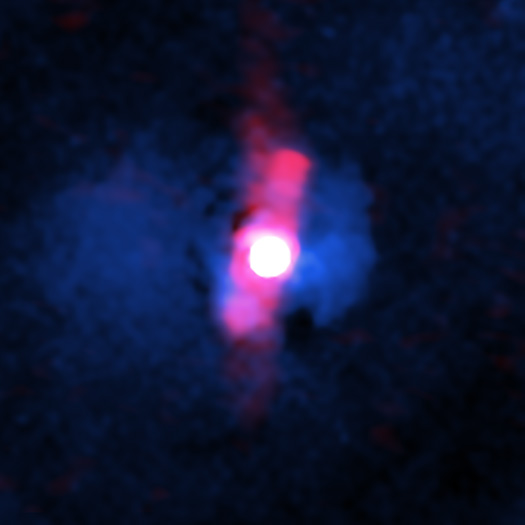NASA's Chandra Identifies an Underachieving Black Hole

Quasar H1821+643
Credit: X-ray: NASA/CXC/Univ. of Nottingham/H. Russell et al.; Radio: NSF/NRAO/VLA; Image Processing: NASA/CXC/SAO/N. Wolk
This image shows a quasar, a rapidly growing supermassive black hole, which is not achieving what astronomers would expect from it, as reported in our latest press release. Data from NASA’s Chandra X-ray Observatory (blue) and radio data from the NSF’s Karl G. Jansky’s Very Large Array (red) reveal some of the evidence for this quasar’s disappointing impact on its host galaxy.
Known as H1821+643, this quasar is about 3.4 billion light-years from Earth. Quasars are a rare and extreme class of supermassive black holes that are furiously pulling material inwards, producing intense radiation and sometimes powerful jets. H1821+643 is the closest quasar to Earth in a cluster of galaxies.
Quasars are different than other supermassive black holes in the centers of galaxy clusters in that they are pulling in more material at a higher rate. Astronomers have found that non-quasar black holes growing at moderate rates influence their surroundings by preventing the intergalactic hot gas from cooling down too much. This regulates the growth of stars around the black hole.
The influence of quasars, however, is not as well known. This new study of H1821+643 that quasars — despite being so active — may be less important in driving the fate of their host galaxy and cluster than some scientists might expect.
To reach this conclusion the team used Chandra to study the hot gas that H1821+643 and its host galaxy are shrouded in. The bright X-rays from the quasar, however, made it difficult to study the weaker X-rays from the hot gas. The researchers carefully removed the X-ray glare to reveal what the black hole’s influence is, which is reflected in the new composite image showing X-rays from hot gas in the cluster surrounding the quasar. This allowed them to see that the quasar is actually having little effect on its surroundings.
Using Chandra, the team found that the density of gas near the black hole in the center of the galaxy is much higher, and the gas temperatures much lower, than in regions farther away. Scientists expect the hot gas to behave like this when there is little or no energy input (which would typically come from outbursts from a black hole) to prevent the hot gas from cooling down and flowing towards the center of the cluster.
A paper describing these results has been accepted into the Monthly Notices of the Royal Astronomical Society and is available online. The authors are Helen Russell (University of Nottingham, UK), Paul Nulsen (Center for Astrophysics | Harvard & Smithsonian), Andy Fabian (University of Cambridge, UK), Thomas Braben (University of Nottingham), Niel Brandt (Penn State University), Lucy Clews (University of Nottingham), Michael McDonald (Massachusetts Institute of Technology), Christopher Reynolds (University of Maryland), Jeremy Saunders (Max Planck Institute for Extraterrestrial Research), and Sylvain Veilleux (University of Maryland).
NASA's Marshall Space Flight Center manages the Chandra program. The Smithsonian Astrophysical Observatory's Chandra X-ray Center controls science from Cambridge Massachusetts and flight operations from Burlington, Massachusetts.
Please note this is a moderated blog. No pornography, spam, profanity or discriminatory remarks are allowed. No personal attacks are allowed. Users should stay on topic to keep it relevant for the readers.
Read the privacy statement
